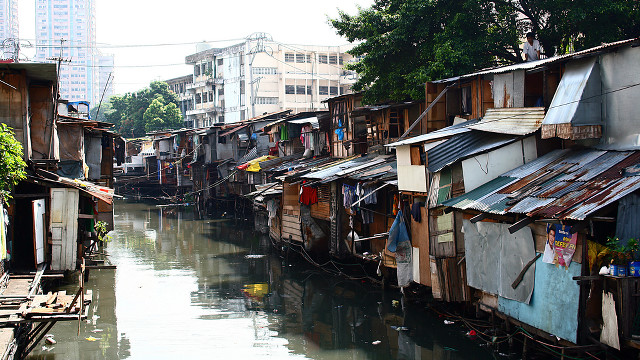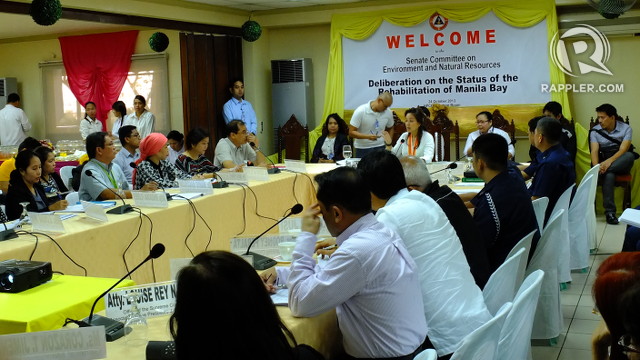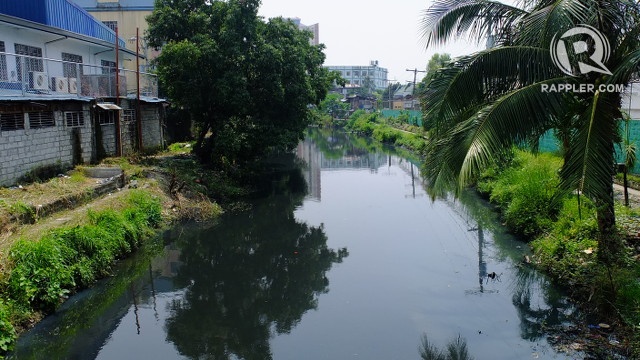SUMMARY
This is AI generated summarization, which may have errors. For context, always refer to the full article.

MANILA, Philippines – The Department of the Interior Local Government (DILG) will relocate 20,000 informal settler families living on top of waterways leading to Manila Bay by the end of 2013.
This commitment was announced during the October 24 briefing on the rehabilitation of Manila Bay in which various government agencies like the Manila Bay Coordinating Office (MBOC), Metro Manila Development Authority (MMDA), Bureau of Fisheries and Aquatic Resources (BFAR), Department of Public Works and Highways (DPWH), Philippine Coast Guard and Philippine National Police gave updates on their efforts to clean up the bay.
“There are around 100,000 informal settler families near waterways leading to Manila Bay in NCR [National Capital Region] alone. Of this, 60,000 are located on top of waterways. We are targeting 20,000 of them to be cleared and relocated in 2013,” reported Rhodora Flores, chief of the Policy Compliance and Monitoring Division in the DILG.
The department, along with concerned local government units, are already identifying possible relocation sites which should ideally be near the original location of the families. Once these sites have been identified, the DILG will begin construction of medium-rise buildings which will serve as the new homes of the families.
‘Major pollutants’
Waterways are “danger zones,” said Flores.
Families living above waterways are thus the most vulnerable to the disastrous impacts of floods and earthquakes. They are also at risk of contracting deadly diseases such as malaria, leptospirosis, dengue and typhoid fever. (READ: 55 die daily from lack of proper sewerage)
“That’s why it’s in their best interest to relocate,” said Flores.
Informal settlers living on the waterways are also major pollutants of these waterways. “They don’t have hygienic septic tanks. They don’t have sanitary toilets. They generate solid waste and liquid waste, like the water they use to wash clothes or dishes. They just dump directly into the water,” said Flores.
Giving these families homes away from esteros and canals is one way “to attack at the source” of the problems plaguing Manila Bay, she added. These channels carry water to Manila Bay. To effectively restore the quality of water in the bay, its tributaries must be kept clean.
Protect the bay
Though the DILG is encountering opposition from families who refuse to relocate, they said they are merely upholding the Writ of Continuing Mandamus for the rehabilitation of Manila Bay.
The writ, issued by the Supreme Court in 2008, asks different government agencies to restore Manila Bay waters to class “B” level, meaning fit for swimming and other forms of contact recreation. As a “continuing mandamus,” it requires the agencies to regularly and continuously update the Court with the progress of their clean-up efforts.
The complex problem of the bay “clearly involves the implementation of elaborate sequential activities on environment and sanitation matters with a lengthy time frame,” explained Presbitero Velasco Jr, the Supreme Court justice who penned the decision, in a speech about the writ.
He called it a “continuing open-ended arrangement, a periodic progressive report…The edict for the preservation of the water quality of the bay, after its clean up, has in effect, an unlimited lifespan and validity.”
Progress report
Cleaning up the tributary waterways of Manila Bay is one of they key strategies of the Manila Bay Coordinating Office which it pursues with the help of the DILG and DPWH.
They identified 8 priority waterways as the target of clean-up efforts and relocation of informal settler families (ISFs) living in the area:
1. San Juan River (4,217 ISFs)
2. Estero Tripa de Gallina (3,887 ISFs)
3. Tullahan River (3,683 ISFs)
4. Manggahan Floodway (2,997 ISFs)
5. Maricaban Creek (1,637 ISFs)
6. Pasig River (1,434 ISFs)
7. Estero de Maypajo (1,415 ISFs)
8. Estero de Sunog Apog (170 ISFs)
As of September 30, they have been able to clear, clean and desilt 1,209.502 kilometers covering 129 rivers and 1,134 sections of drainage canals and waterways nationwide.
Another course of action is to make sure establishments and residences living near waterways have septic tanks or waste water treatment facilities to prevent toxics or waste from flowing into the waterways.
Out of the 38,066 commercial establishments inspected by the DILG, 34,131 or 90% have constructed wastewater treatment facilities as of June.
As for private homes, 427,074 or 81% of the 526,392 inspected homes now have septic tanks.
Out of the 1,779 inspected factories, 1,136 or 64% have wastewater treatment facilities.
Gaps, obstacles ahead
Though progress is already being made, MBCO Executive Director Noel Antonio Gaerlan said the day when Manila Bay will be fit for swimming is still a long way off.
“We’re looking at a 25 to 30 year program. Based on the program of MWSS (Metropolitan Waterworks and Sewerage System) and the concessionaires, they can only connect all households and establishments to treatment facilities by year 2037. That’s just one part of the problem,” he told Rappler.
There are 178 LGUs in the Manila Bay watershed area, or the area with waterways contributing to Manila Bay. These encompass LGUs in the National Capital Region, Central Luzon and CALABARZON.
Though all of them are required to have a 10-year Solid Waste Management plan–a plan that would lay down protocols on segregation and proper waste disposal–only Quezon City and Santa Rosa, Laguna have one so far. This year, the DILG hopes to add 35 more LGUs to this short list.
But more alarming is the fact that, to date, no LGU has a Water Quality Plan though having one is required under the Philippine Clean Water Act of 2004. The Water Quality Plan is supposed to establish control mechanisms and strategies to protect water resources and curb water pollution.
No LGU has adopted a Water Quality Plan for the simple reason that the DENR’s Environment Management Bureau is yet to form a National Framework which is meant to serve as a template for localized plans of LGUs. – Rappler.com
Manila slum area image from Shutterstock
Add a comment
How does this make you feel?



There are no comments yet. Add your comment to start the conversation.